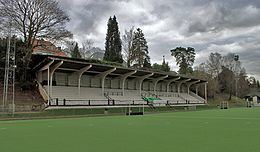Capacity 10,000 | Year built 1902 | |
 | ||
Location Dreve des Gendarmes 125, UccleBelgium Similar Gribaumont metro station, Stade Des 3 Tilleuls, Saint‑Job railway station, Duden Park, Wolvendael Park | ||
The Stade du Vivier d'Oie (Dutch: De Ganzenvijver), meaning "Goose Pond Stadium", is a stadium in the Belgian community of Uccle in the Brussels Capital Region. The stadium lies in the quarter Vivier d'Oie (Dutch: Diesdelle) at the margin of the Soignies Forest. In the first half of the 20th century the football club Racing Club de Bruxelles played here.
History
Racing club was founded at the end of the 19th century and played first in Koekelberg and then at the velodrome of Longchamps at Longchamps ("Long Field") in Uccle. In 1901 the at that moment very successful club in Belgium moved to Vivier d'Oie and here a stadium with side building and club house was built. The tribune was made in armoured concrete, an innovating technique at that moment. It was one of the first covered tribunes that was not made of wood. In this stadium, at 1 May 1904 the Belgian national football team played its first official football match, a 3–3 tie against France. After the First World War it also became a sports ground for field hockey. In 1923 a cottage was built, designed by Uccle's architect Fritz Seeldraeyers. During the Interbellum the decorated concrete entrance gate was made with the inscription "ROYAL RACING CLUB DE BRUXELLES".
After the Second World War the football section of the club played in the highest division again, and the stadium became too small for them. Therefore, the athletic and football sections moved over to the new Drie Linden Stadium in Watermael-Boitsfort. The football section fused with another club in 1963 en got separated from Racing Club de Bruxelles in doing so. The hockey and tennis sections kept playing in the Stade du Vivier d'Oie spelen. In 1963 a new club house was built.
In 2010 the sports complex got protected as a monument.
